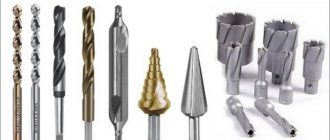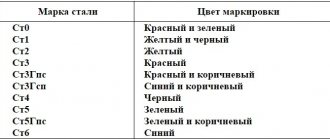Hardness HRC is one of the main characteristics of the tool. The parameter displays the strength characteristics of the product, determines its resistance to deformation and abrasive wear. The higher the hardness of HRC steel, the more reliable, durable and functional the product.
In the material:
- Rockwell method
- Locksmith tool
- Installation tool
- Metal cutting tool
- Fasteners
- Methods for determining hardness Stationary hardness testers
- Portable hardness testers
- Files
Rockwell method
The Rockwell method is the most popular method for determining hardness. The procedure is regulated by GOST 9013-59 and involves pressing one of the types of indenters into the sample:
- diamond cone for hard steels and hardened alloys;
- carbide ball for non-ferrous metals and alloys with moderate hardness.
When carrying out work, specialized equipment is used. It ensures reliable fixation of the workpiece, systematic immersion of the indenter and display of measurement results.
Rice. 1 Hardness measurement using the Rockwell method
The Rockwell hardness measurement method involves the use of various scales with letter designations. Scales A and C are used to work with diamond indenters, scale B – with carbide balls.
IMPORTANT! When measuring metal hardness using the Rockwell method, information about the scale used is displayed at the end of the designation. For example, the expression 57 HRC indicates that the hardness of the workpiece is 57 units, tests were carried out by the Rockwell method (HR) using the C scale.
When measuring the hardness of metals using the Rockwell method, you cannot compare the values obtained when working with different scales. These are fundamentally different indicators, focused on certain types of materials.
Measurement by the Rockwell method according to GOST involves the use of the following ranges of values.
- Carrying out tests in accordance with scale A - from 70 to 93 HR.
- Using the Rockwell measurement method within the B scale - from 25 to 100 HR.
- Determination of steel hardness HRC (scale C) - from 20 to 67 HR.
When working with tools and fasteners, it is customary to use the C scale. Each group of products has recommended hardness values. Compliance with the specified values guarantees long service life of the product.
Rockwell knife hardness scale
HRc - Rockwell Hardness Scale: everything you wanted to know
Anyone who has at least once bought a high-quality knife has undoubtedly come across the concept of “blade hardness” and the abbreviation HRc. Have you ever wondered what this means? If yes, then you are not alone.
Rockwell hardness determination
The abbreviation HRc stands for Rockwell Hardness Scale, Section C. It is widely used by metallurgists to determine the hardness of steel: the higher the number, the greater the hardness. The value of hardness is of great importance in the production of knives, because... The harder the steel, the better it retains its cutting edge.
The Rockwell scale has several sections, each of which is used to determine the hardness of a specific material. Section C is for determining the hardness of knife steel.
The highest RC rating does not always mean the best knife
On the one hand, harder steel holds the cutting edge better, however, the likelihood of cracks and even breaking off is higher. In truth, a really hard blade can break into pieces like glass.
How a knife will hold a cutting edge is affected not only by the hardness of the steel, but also by its type and grade. Each steel alloy has an optimal balance of hardness and functionality depending on the purpose of the knife.
Why then does the Rockwell scale matter? What is the optimal value for knives?
The hardness of the blade is as important as its functionality and wear resistance. For example, steel with a hardness of 58-62 on the Rockwell scale will hold an edge well, but it is also less strong, more brittle and prone to cracking. Thus, a tool with an exceptionally high blade hardness requires special care and handling.
At the same time, softer metal is more wear-resistant, but it will have to be sharpened much more often. Thus, in the production of axes and chisels, steel with a lower hardness index is used, however, such material can easily withstand significant impact.
Pocket folding knives and hunting knives are not typically used for splitting wood, so edge retention is more important than durability. Consequently, harder metal is used in the production of such tools. However, when it comes to survival knives, the requirements are different. A hardness of 55-58 Rockwell units will be more than enough for them, because. Strength and wear resistance come first here.
Optimal hardness depends on the purpose of the knife, so there is no single indicator that is ideal for all knives
Many abbreviations - one scale
In relation to this method of determining hardness, knife manufacturers use many abbreviations: HR, HRc, HR C, RC, Rockwell C, Rockwell C, Rockwell C... Regardless of which abbreviation is used to describe a knife, it means one single Rockwell hardness scale.
History of creation
Stanley P. Rockwell was a metallurgist at a ball bearing plant in New England in 1919. He developed his system for quickly and accurately determining the hardness of a bearing's rolling surface.
Manufacturers of a variety of products, from watch springs to carriage wheels, needed such a system and quickly adopted Rockwell's design for their own needs. Subsequently, the system was adapted to determine the hardness of non-metallic materials, in particular plastics.
How is Rockwell hardness determined?
The scale measures the relative hardness of a metal using the indentation method. Before performing the test, the metal must be hardened and made completely flat. Otherwise the measurements will not be accurate.
Hardness measurements typically use a diamond-tipped cone that is pressed into the metal being tested with a force of 300 pounds. Then the depth of its insertion is measured taking into account the applied force. As a result, the data is correlated with a scale that already contains information about the hardness of other tested metals.
This method has one small drawback: a small depression from the tip of the cone remains on the metal surface, which can be mistaken for a defect. This mark can be avoided if the test is carried out on a surface hidden from view, for example, by the handle of a knife.
Why do RC rates vary?
The Rockwell test is performed on a very small area of metal, so there is a possibility that the hardness of the adjacent area will be slightly different. In addition, this test only tests the surface of the material, while the hardness in depth may be different.
It is for this reason that knife manufacturers usually indicate not a single hardness value, but a range.
Price-quality ratio
Rockwell hardness testing helps knife manufacturers balance the 3 most important criteria affecting the quality of the final product: hardness, flexibility and rigidity. The perfect balance of these three components allows them to create a knife that will sharpen perfectly and retain its cutting edge for a long time, even with active use.
Once you buy one of our high-quality knives, you'll immediately understand what we're talking about.
Larry Connelly
Locksmith tool
In the manufacture of metalworking tools, alloy and carbon steels are used. The hardness of the HRC material must be within the following ranges:
- files and replaceable cutting blades for hacksaws - from 56 to 64 units;
- scribers, punches, chisels and bits - from 54 to 60 units;
- percussion instrument, represented by hammers and their analogues - from 50 to 57 units.
Hardness 56 HRC is a universal indicator. The value confirms the high strength of products for all of the listed groups.
Installation tool
Mounting tools are widely used in production and at home. The degree of hardness determines the wear rate and strength characteristics of the product.
For each type of product, the recommended hardness level is determined:
- wrenches with a gap up to 36 mm - from 45.5 to 51.5 units;
- wrenches with a gap of more than 36 mm - from 40.5 to 46.5 units;
- screwdrivers - from 47 to 52 units;
- clamping tools, represented by pliers, pliers and forceps - from 44 to 50 units.
Hardness 52 HRC is optimal for most products. Products with this indicator have a long service life and sufficient strength.
Metal cutting tool
High hardness is a prerequisite for high-quality metal-cutting tools. It will help maintain the sharpness of the edges and reduce the frequency of sharpening and other service procedures.
For each instrument group, the corresponding values on the HRC scale are recommended:
- cutting tools in the form of nippers and side cutters - from 56 to 61 units;
- countersinks and countersinks - from 61 to 65 units;
- taps and dies – from 61 to 64 units;
- drills for working with metal – from 63 to 69 units;
- cutters, the production of which uses HSS steel - from 62 to 66 units.
For drills coated with titanium nitride, the HRC blade hardness must be above 80 units. The requirements are due to the high load on the tool during operation.
Knife R009 - from 3800 rubles
Basic steel - damask steel (from 5300rub)
Possible steel options - EI107TC (crucible remelting) - the cost of such knives is 3800 rubles
Handle options - any
A reliable hunter's knife that will not let you down in any situation
Buryat hunting knives - from 3050 rubles
Base steel - 95Х18
Possible steel options - 100Х13М, 110Х18МШД, Elmax, Damascus grades ZD0803 (rusting) and ZD1016 (stainless)
Handle options - walnut, Karelian birch, birch bark or leather,
A very convenient and versatile knife, a bestseller for more than 3 years.
Fasteners
When determining the reliability of fasteners, not only hardness is taken into account, but also the strength class. These parameters are closely related to each other.
Table No. 1. Relationship between strength and hardness class HRC for bolts, screws, nuts and washers
For other fasteners, there are ranges of recommended strength values.
Table No. 2. Recommended strength values for other fasteners
Methods for determining hardness
To determine hardness using the Rockwell method, stationary and portable hardness testers are used. If you have a limited budget, special files are used.
Stationary hardness testers
Stationary hardness testers are high-precision measuring instruments. The devices are installed in laboratories and provide optimal conditions for conducting experiments.
The most advanced hardness testers have software control and allow you to configure the procedure parameters in detail. The equipment is regularly verified and adapted for intensive use.
Rice. 2 Stationary hardness tester
Portable hardness testers
Portable measuring instruments are designed for on-site measurements. They are small in size and retain functionality in various spatial positions. Most devices have liquid crystal displays and support the function of storing and comparing values.
IMPORTANT! It is recommended to purchase certified hardness testers, accompanied by documentation from the manufacturer. Such devices allow measurements using the Rockwell method according to GOST 9013.
Rice. 3 Portable hardness tester
Files
Using special files is the most accessible way to measure hardness. The tool is supplied in sets. They contain several files, each of which is oriented to a specific hardness (the corresponding designation is on the handle of the tool).
Rice. 4 Set of files for hardness testing
Tests are carried out in a certain sequence.
- The workpiece is clamped in a vice or fixed in another reliable way.
- The test surface is alternately exposed to files. The master starts with the tool that has the least hardness. If it does not leave scratches, use the next file from the line.
- As soon as marks appear on the workpiece, changing files stops. The master compares the hardness of the last and previous tools. The intermediate value is the HRC value for the part being tested.
Files are not used in laboratory research due to low measurement accuracy. They are intended for domestic use and ordinary industrial operations.
Rice. 5 Schemes for working with a file
Why is hardness important?
In physics, hardness is the ability of a body to resist the penetration of another substance into it (which leads to a change in shape). In the knife industry, it is optimal if the blade can remain sharp for a long time (not deform, crumble or become dull), be resistant to lateral loads, but at the same time accept manual sharpening when using a suitable tool.
A blade that is too hard can break if it comes into contact with another solid body (bones, frozen meat), and sharpening it with your own hands will be problematic - the metal will not respond to the influence of a sharpening tool.
Steel that is too soft, on the contrary, will become wrinkled when it comes into contact with the surface of a dense product and will require straightening. Giving the correct geometry will not be difficult, but the next deformation will not be long in coming. As a result, the knife will have to be edited and sharpened too often, and the quality of the cut will be very mediocre.









